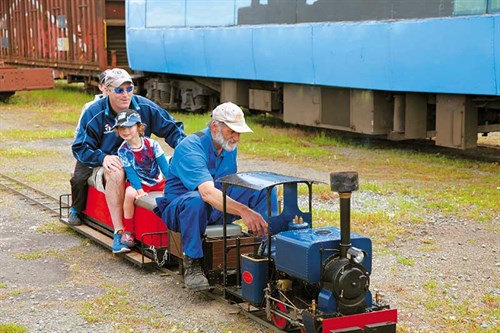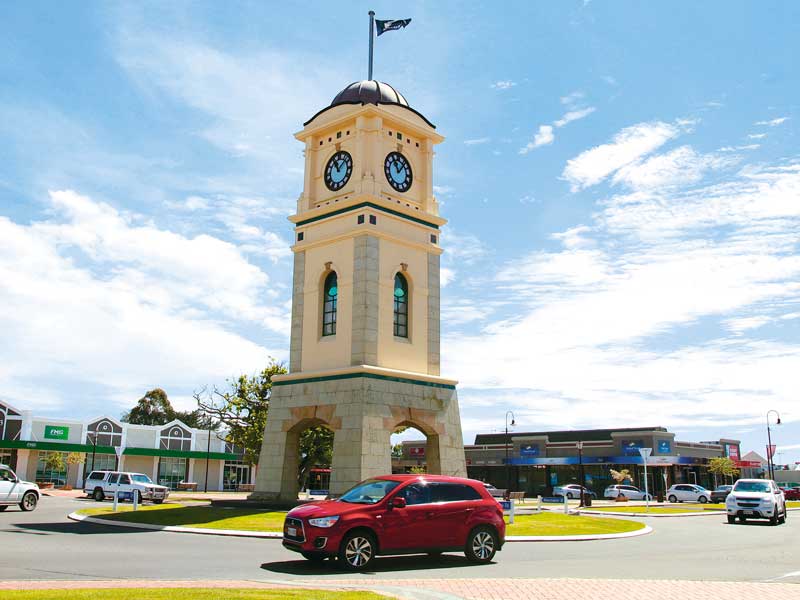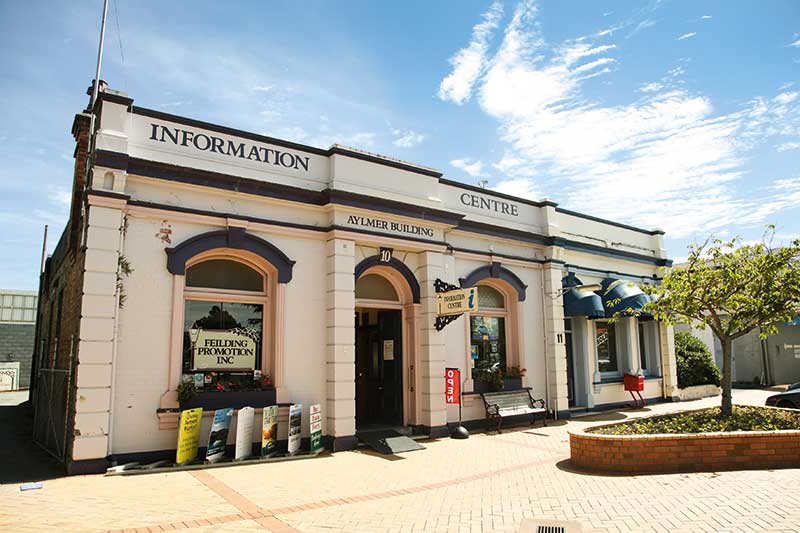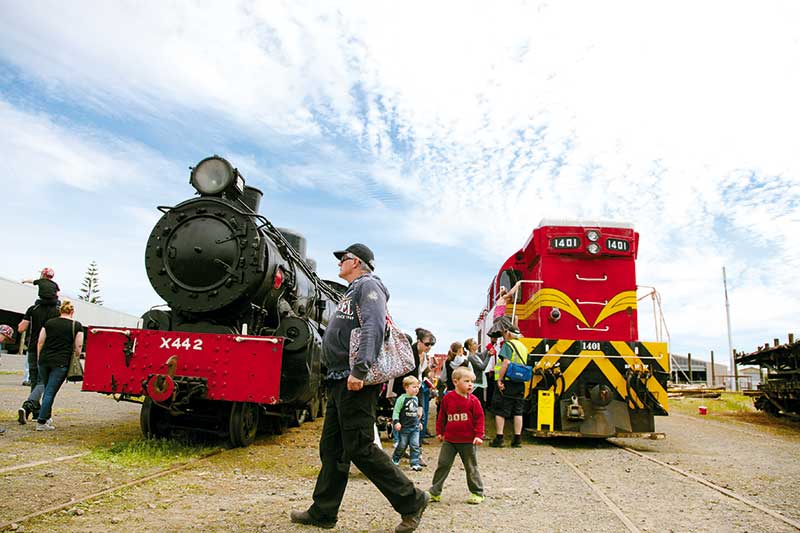Visiting a town you are not acquainted with can be like throwing a dart at a dartboard, so it’s important to find the right cafe to sit with a few guides and maps to decide where to go.
I liked the one that had window seats and a view of the pavement. It was humming with customers and, after ordering coffee and a bite to eat, a lady offered me a seat at her table but because Glenn and I were making a beeline for the window seats, I politely declined. It struck me as being such a friendly gesture and there it was: the first friendly act in Feilding. How good was this?
Then, leaving the cafe, I saw a car with a bumper sticker that read ‘I love living in friendly Feilding’, so here was further evidence of this good vibe.
At Feilding Information Centre, I asked Cohen Stephens, who was manning the desk, why is Feilding spelt the way it is: ‘ei’ instead of the usual ‘ie’? (This is particularly mystifying when you have Field days in Feilding).
They must get asked this all the time, because out came a printed card with the following information. It said, ‘Feilding was named after Colonel Feilding who started the settlement here in 1871. Over 200 years ago many people couldn’t spell and so one branch of the family became Feilding. We like it this way; it is unique, so please do us the courtesy of spelling it accordingly.’
Having clarified that, he gave us a few pointers on what to do on this lovely November Saturday. And there was plenty happening.
The Feilding and District Steam Rail Society was having its open day. A crowd had gathered to watch as vintage steam engines puffed up and down the track. Happy passengers peered out the train windows as black smoke swirled above. They may not have been going far but that didn’t seem to matter.
One of the trains in action that day, the F163 locomotive, was built in Glasgow in 1880. It was shipped to New Zealand in 1881 and worked until it ‘retired’ in 1967. Having been fully restored, it has a new lease of life and is much admired by old and young alike.
We wandered through the workshop where a graveyard of old trains awaits resurrection. A sign said ‘Queen’s Car’ so we presumed that on one of her visits, Queen Lizzie must have looked out at the New Zealand countryside from there.
At Manfeild Park, the buzz of the 30th MG Classic car race could be heard; we had intended to go and watch but decided instead to explore Kowhai Park.
I know ducks are only friendly because they think you are going to feed them, but these ones were extra willing to pose beside their pond so I gave them the tick of approval too.
As we left the park, cricketers were gathering for a game. No chance of match fixing here I bet! On the perfectly manicured green, groups of people were sprawled out enjoying the peaceful atmosphere.

At The Coach House Museum, visitors are able to get a fantastic glimpse into the district’s history and learn how immigrants carved out new settlements from the bush.
There’s a comprehensive collection of carefully restored artifacts that demonstrates what daily life in the new colony was like. And what hard work it must have been! “Aren’t you glad you weren’t a woman of those times?” says our museum visitor host, Brian Hunter. “I am indeed,” I agree, looking at an exhibit of domestic items with none of the labour-saving devices we take for granted today.
The museum has the biggest collection of horse- drawn vehicles in one place in New Zealand. I’m particularly taken with a brightly painted, spring cart. It belonged to Chinese market gardener, Chung Lee who delivered vegetables in this until 1966.
There’s also a long line of bright green and yellow, vintage John Deere tractors – apparently the biggest collection in the Southern Hemisphere. Tractors such as these helped revolutionise farming practices in the early 1900s.
We chatted to another museum host, Alan Hodges, who came from Wales to live in Feilding in 1961. He told us, “People can sell a house in Auckland and buy a comfortable house here and still have money in their pocket.” And to my question of why the town has such reputation for friendliness? “Oh it’s always been like this. And do you know, we don’t have parking meters or traffic lights? The farmers’ market every Friday is very popular, as are the sale yards tours. Feilding is a very busy and progressive place.”He mentions that self-contained motorhomes are welcome to park in the Coach House Museum car park, which has secure surroundings and is close to town.
The Feilding Rose & Flower Show is on in the Feilding Bible Chapel. I love events like this – they are such feel-good occasions with raffles and afternoon tea on offer. The lady on the sales table told me that Feilding is a very community minded place, that everybody helps one another and “if you are lying at home feeling all sad and sorry, there’s always somewhere to go for a chat.”
After a morning spent exploring, a late lunch at Murray’s Irish Public House is in order. Here we find welcoming bar staff and an excellent-value, $10 lunch. Wow – what’s not to like about Feilding? There has not been one sour face to sully its sunny reputation.
And so, as satisfied visitors, we leave this rural town with its wide streets and distinctive clock tower, the bronze sculpture of a drover and his dog and the welcome sign with Murray Ball’s cartoon of Footrot Flat’s sheep dog, Dog, snoozing on a sheep’s back.
One last port of call we had to make, however, was to Colyton Clocks in Feilding’s rural hinterland. As we drove in, owner Bill Williams emerged from the agapanthus where he was wrestling with a tangle of Christmas lights. Bill is big on Christmas and he’s big on clocks – he has a collection of 3458, which he’s been gathering for 27 years.
His wife, Cathy, has a large collection of mermaids, and fortunately, they are tolerant of each other’s crazes.
There are Elvis clocks, cuckoo clocks, crystal clocks, ship’s clocks and a grandfather clock made painstakingly from matchsticks by a prisoner – with time on his hands… oh, bad joke. Its time we left Feilding, we have become far too happy.
Never miss an issue of Motorhomes Caravans & Destinations magazine. Subscribe here.








